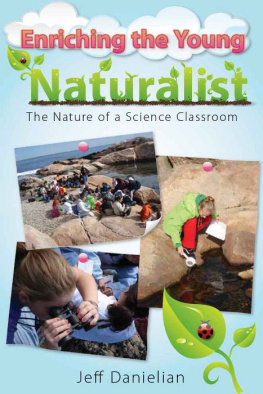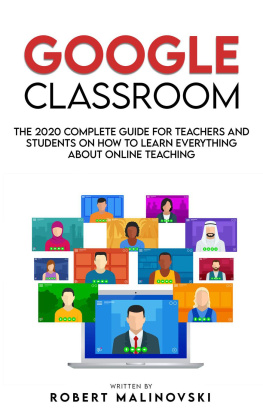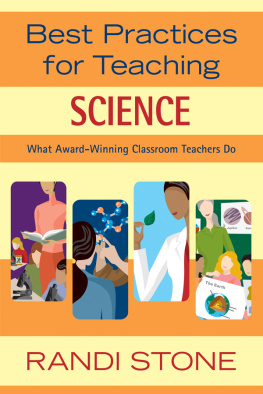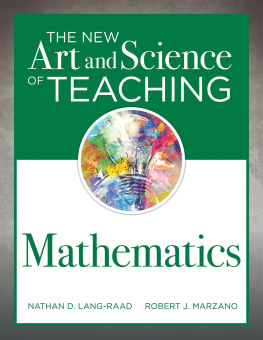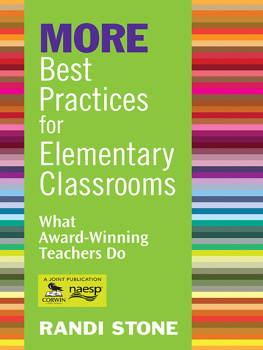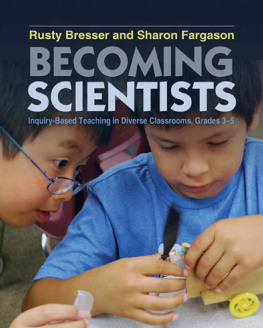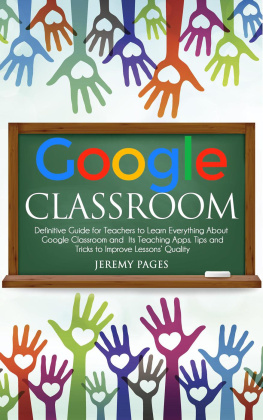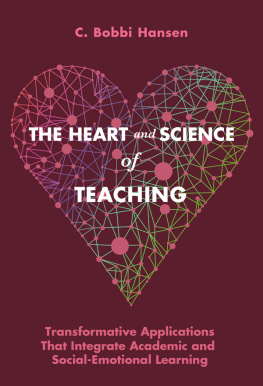

The Nature of a Science Classroom
Jeff Danielian

PRUFROCK PRESS INC.
WACO, TEXAS
Copyright 2009 Prufrock Press Inc.
Edited by Rich Restaino
Cover and Layout Design by Marjorie Parker
ISBN-13: 978-1-59363-581-7
No part of this book may be reproduced, translated, stored in a retrieval system, or transmitted, in any form or by any means, electronic, mechanical, photocopying, microfilming, recording, or otherwise, without written permission from the publisher.
Printed in the United States of America.
At the time of this books publication, all facts and figures cited are the most current available. All telephone numbers, addresses, and Web site URLs are accurate and active. All publications, organizations, Web sites, and other resources exist as described in the book, and all have been verified. The author and Prufrock Press Inc. make no warranty or guarantee concerning the information and materials given out by organizations or content found at Web sites, and we are not responsible for any changes that occur after this books publication. If you find an error, please contact Prufrock Press Inc.

Prufrock Press Inc.
P.O. Box 8813
Waco, TX 76714-8813
Phone: (800) 998-2208
Fax: (800) 240-0333
http://www.prufrock.com
For Samantha and Grace
Acknowledgements
I would like to thank:
- First and foremost, all of my professors at Lyndon State College, where I received my undergraduate degree in natural science. It was through the eyes of Bud Ebbett, Dave Conant, John Pellerin, Don Miller, and Michael Sherbrooke that I learned to see the world. Without them I would never have opened my eyes.
- The late Jim Doyle, professor of English at Lyndon State, who gave me the gift of literature.
- All of my professors at the University of ConnecticutJoe Renzulli, Sally Reis, Del Siegle, Sally Dobyns, Susan Baum, and Jann Leppienwho opened up the world of education for me and taught me to believe in myself.
- My cohorts in the Three Summers Program at the University of Connecticut, whose continued encouragement made this work possible.
- Jennifer Robins at Prufrock Press, for her insight and ideas at the beginning of this process, and careful analysis during the completion of the project.
- My editor, Rich Restaino, whose invaluable ideas, insight, and suggestions provided a level of comfort throughout the entire process of completing this book.
- Terry Neu, for my first introduction to the merging of nature and education.
- My nephew, Luke Douglas, the youngest ornithologist I know.
- My fellow educators at the PEGASUS program in Providence, RI, where I have been supported in my efforts to teach the naturalist curriculum.
- My coworkers at the National Association for Gifted Children who support all that I do.
- Elizabeth Fogarty for her expert review of the initial draft of this text.
- Loren Eiseley, for The Immense Journey.
- My mom and dad, who gave me the gifts of exploration, independence, and wonder.
- My sister and brother, who experienced life with me in our family.
- All of my good friends, for their unending support.
- Most importantly, my wife Samantha, my daughter Grace, and my son Cooper, the best gifts nature has ever brought to me.
Note to the Reader
I f you have picked up a copy of this book, then you probably agree that science instruction needs to encompass more than mathematical formulas and memorization of terms. At its core, science implies observing, asking questions, and exploring and categorizing the natural world. To help bring this basic element of science back into the curriculum is the purpose of this book. This text presents only a small survey of the vast amount of material on teaching the naturalist disciplines. I have tried my best to clearly lead the reader through the journey of teaching students to explore, appreciate, and come to understand what it means to be a naturalist.
Because of the volume of information that exists in each of the naturalist disciplines, not much space is given to discussing the specific peculiarities of studying geology, zoology, botany, and so on. Instead, I have focused on the processes and information common to teaching students to engage in all of these studies. I have found it essential to success to allow the students to be exposed to a variety of ideas and interesting topics related to naturalistic studies; this adds an essential motivating element of choice. Information about specific naturalist disciplines can be found in many of the wonderful resources I reference throughout the book.
This book essentially is a guide to teaching your students to become naturalists. Because so many of the specifics in your lessons will be determined by the natural world in your neck of the woods, I chose not to write a unit of hard-and-fast lessons that should be followed to the letter. Besides being anathema to the spirit of naturalism, such rigidity would not accommodate variables such as time, location, and so on. In many of the chapters, I recommend a particular course of study and include handouts, assessments, and rubrics. The samples included have been successful in guiding my students; however, feel free to modify them or create your own. Other lessons are more open-ended in terms of assignments and assessments. Rather, these chapters give suggestions for activities and experiences that will support your students journey toward becoming naturalists, leaving the specifics of instruction and assessment up to the teacher.
I am a true believer in teaching by encouragement and I often personalize all graded work with comments and suggestions for improvement, tending to stay away from strict grading methods. The naturalist discipline offers the opportunity for ascending intellectual demand. Due to the nature of the work, students who require more expertise have the occasion to attain it, and those in need of aid will receive it.
You will notice boxes titled Teacher Talk spread throughout the text. These present actual language that I have used with my students in order to motivate, engage, and excite them throughout the course of study. Feel free to use my words, or incorporate your own.
At the end of each chapter, I have included a list of resources and Web sites that you may find useful. Some of the references are field guides, and some are novels and collections of essays. At the end of the book I have included another list of resources, mostly books and articles that support this view of teaching and enriching the young naturalistjust in case anyone wonders what it is youre doing there in your classroom!
Remember, the young people you have in your classrooms are the future stewards of the Earth, and we need them more than ever.
Introduction
H ow do we as educators get students to see the beauty and wonder of what is around them in the natural world? Why must science instruction be laid out in terms of formulas, vocabulary words, and quick surveys of subject areas? Where has the exploration and discovery gone? And finally, how might we accomplish the greatest goal of all: allowing students to pursue their own interests in science in order that they might make contributions to society as a whole?
Next page
